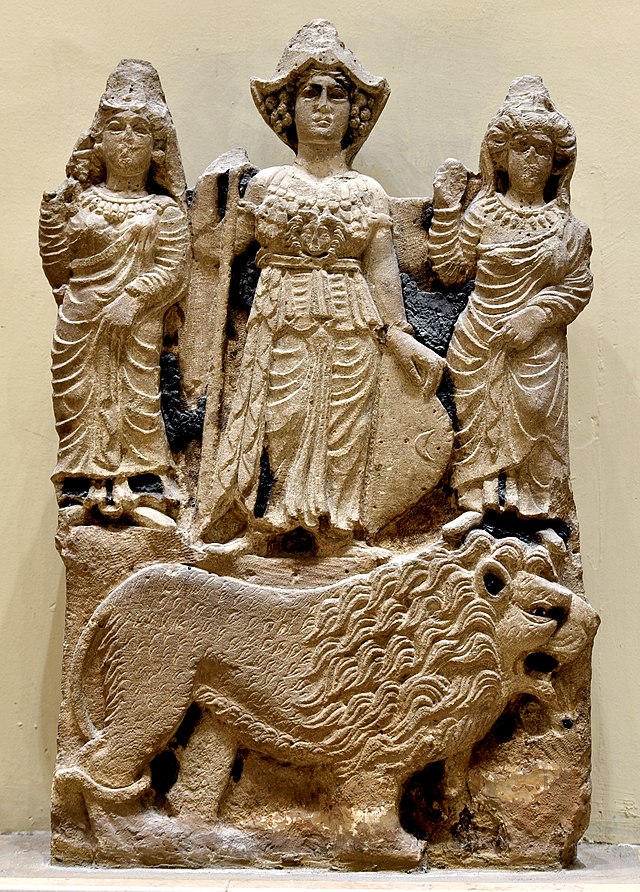Loading AI tools
Pre-Islamic Arabian goddess From Wikipedia, the free encyclopedia
Al-ʻUzzā (Arabic: العزى al-ʻUzzā [al ʕuzzaː] or Old Arabic, [al ʕuzzeː]) was one of the three chief goddesses of Arabian religion in pre-Islamic times and she was worshipped by the pre-Islamic Arabs along with al-Lāt and Manāt. A stone cube at Nakhla (near Mecca) was held sacred as part of her cult. She is mentioned in Qur'an 53:19 as being one of the goddesses who people worshipped.


Al-ʻUzzā, like Hubal, was called upon for protection by the pre-Islamic Quraysh. "In 624 at the 'battle called Uhud', the war cry of the Qurayshites was, "O people of Uzzā, people of Hubal!".[1] Al-‘Uzzá also later appears in Ibn Ishaq's account of the alleged Satanic Verses.[2]
The temple dedicated to al-ʻUzzā and the statue was destroyed by Khalid ibn al Walid in Nakhla in 630 AD.[3][4]
According to the Book of Idols (Kitāb al-Aṣnām) by Hishām ibn al-Kalbī[5]
Over her [an Arab] built a house called Buss in which the people used to receive oracular communications. The Arabs as well as the Quraysh used to name their children "‘Abdu l-ʻUzzā". Furthermore, al-ʻUzzā was the greatest idol among the Quraysh. They used to journey to her, offer gifts unto her, and seek her favours through sacrifice.[6]
This last phrase is said to be the source of the so-called Satanic Verses; the Arabic term al-gharānīq is translated as "most exalted females" by Faris in the Book of Idols, but he annotates this much-argued hapax legomenon in a footnote as "lit. Numidian cranes."
Each of the three goddesses had a separate shrine near Mecca. The most prominent Arabian shrine of al-ʻUzzā was at a place called Nakhlah near Qudayd, east of Mecca toward aṭ-Ṭā’if; three trees were sacred to her there (according to a narration through al-'Anazi Abū-‘Alī in the Kitāb al-Aṣnām.)
She was the Lady ‘Uzzayan to whom a South Arabian offered a golden image on behalf of his sick daughter, Amat-‘Uzzayan ("the Maid of ‘Uzzayan")
‘Abdu l-‘Uzzá ["Slave of the Mightiest One"] was a favourite proper name before the advent of Islam.[7] The name al-‘Uzzá appears as an emblem of beauty in late pagan Arabic poetry quoted by Ibn al-Kalbī, and oaths were sworn by her.
Susan Krone suggests that the identities of al-‘Uzzá and al-Lāt were fused in central Arabia uniquely.[8]
On the authority of ‘Abdu l-Lāh ibn ‘Abbās, at-Tabari derived al-ʻUzzā from al-‘Azīz "the Mighty", one of the 99 "beautiful names of Allah" in his commentary on Qur'an 7:180.[citation needed]
Shortly after the Conquest of Mecca, Muhammad began efforts to eliminate the last cult images reminiscent of pre-Islamic practices.
He sent Khalid ibn Al-Walid during Ramadan 630 AD (8 AH) to a place called Nakhlah, where the goddess al-ʻUzzā was worshipped by the tribes of Quraish and Kinanah. The shrine's custodians were from Bani Shaiba. Al-ʻUzzā was considered the most important goddess in the region.
Arab Muslim historian Ibn al-Kalbī (c. 737–819 CE) tells how Muhammad ordered Khālid ibn al-Walīd to kill the pre-Islamic Arabian goddess al-ʿUzzā, who was supposed to inhabit one of three trees:
According to Easton's Bible Dictionary, Uzza was a garden in which Manasseh and Amon were buried (2 Kings 21:18, 26). It was probably near the king's palace in Jerusalem, or may have formed part of the palace grounds. Manasseh may have acquired it from someone of this name. Another view is that these kings were culpable of idolatry and drew the attention of Ezekiel.[10]
Seamless Wikipedia browsing. On steroids.
Every time you click a link to Wikipedia, Wiktionary or Wikiquote in your browser's search results, it will show the modern Wikiwand interface.
Wikiwand extension is a five stars, simple, with minimum permission required to keep your browsing private, safe and transparent.